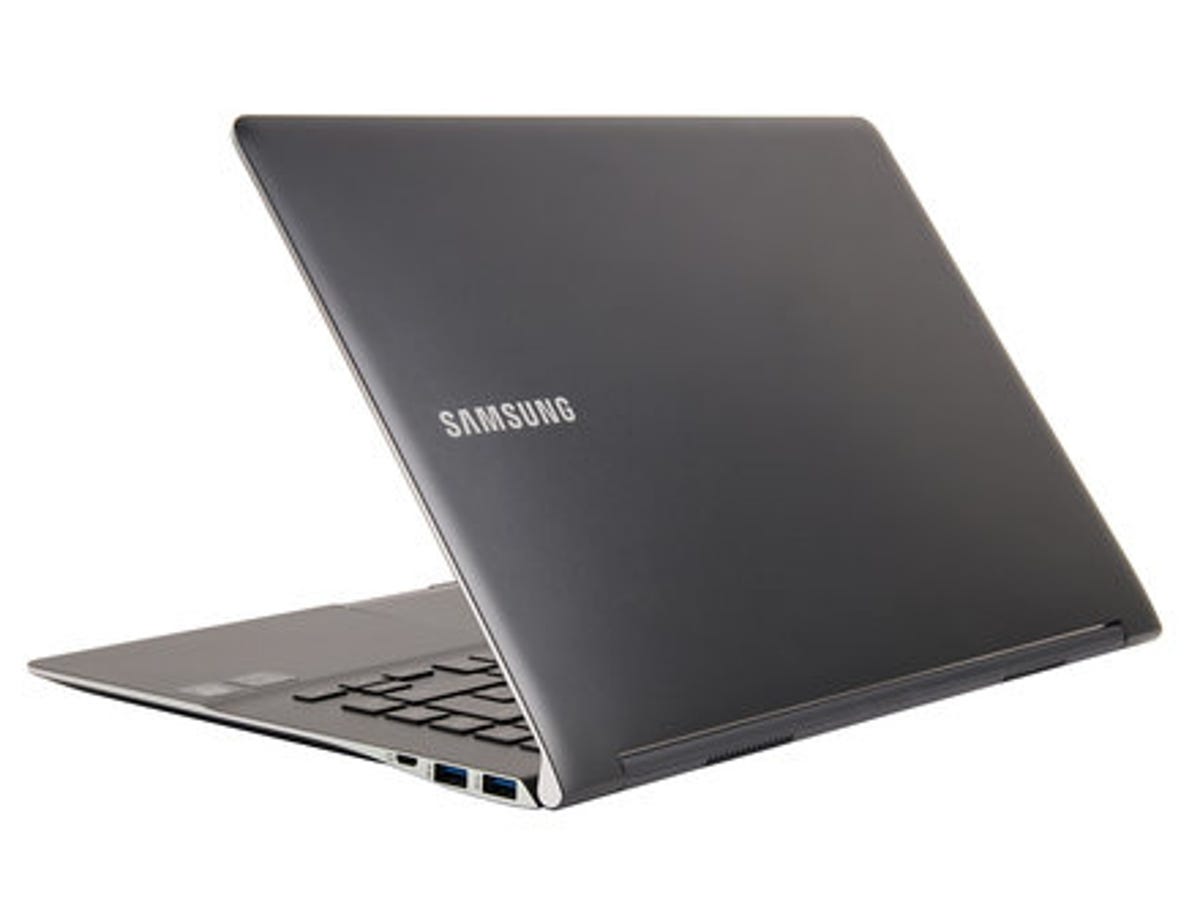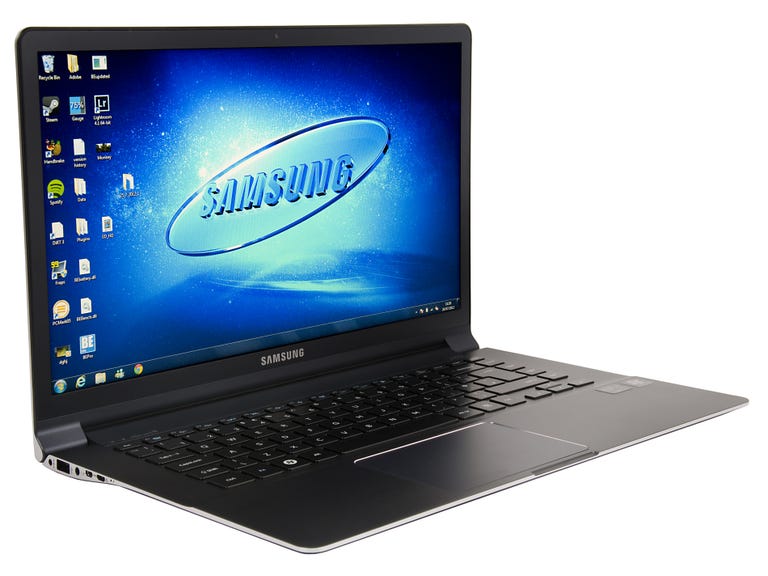 Why You Can Trust CNET
Why You Can Trust CNET Samsung Series 9 review: Samsung Series 9
The updated Samsung Series 9 packs the latest Intel Ivy Bridge chip into a super-slim and sexy shell for intense work on the move.
When Samsung first released its Series 9 ultra-portable laptop last year, we were blown away by the power it generated from such a slim body. With the rise of the ultrabook though, more and more companies have been able to offer similar products for less money, meaning that when Samsung launched its pricey update earlier this year, I wasn't bowled over.
The Good
The Bad
The Bottom Line
Not wanting to fade into the shadows, Samsung has ripped out the old processor and replaced it with one of Intel's latest line of Ivy Bridge chips. That's a big wallop of extra power for the same price as the previous model.
At 15 inches, it's bigger than the majority of ultrabooks, but it's still slimmer than most. It might be the ideal travelling companion if you demand a little more oomph from your laptop.
My Series 9 900X4C review model came with an Intel Core i5 processor, 8GB of RAM and a 128GB solid state drive. It can be bought now for £1,200.
Design and build quality
From the outside, you probably wouldn't notice any difference between this generation Series 9 and the previous one. The most important updates are to be found inside the metal shell. That's not necessarily a bad thing though as the Series 9 is an excellent-looking machine.

In my review of the last model, I argued the matte blue finish wasn't as attractive as the brushed black metal of the original Series 9. When I opened the box on this model, I couldn't help but find it monumentally pretty. Sure, it doesn't have the same 'industrial' appeal of the black one, but the blue colour and carved silver edges are equally stylish and mature enough for a table in a posh Mayfair cafe or a meeting room, displaying the quarterly results (just make sure the lines all go up).
Samsung still reckons that the Series 9 isn't an ultrabook -- that title is reserved for its Series 5 laptop. It does tick every box I know to qualify as an ultrabook, so this is probably just because it hasn't been made in collaboration with Intel. Whatever you want to call it, it's extremely slim. It measures only 13mm thick, which is quite a lot slinkier than ultrabooks like HP's Envy 14 Spectre. It weighs around 1.6kg, which is easily light enough to chuck into a bag and haul around town.
Like the previous generation, the new Series 9's whole chassis is carved from aluminium. Pressing down on the lid, you'll find no flex at all, and the same is true of the wrist rest and keyboard tray. This all adds up to a superbly sturdy machine. I'd have no qualms at all about carrying it off on a rough-and-tumble road trip -- although I'd be in constant fear of scuffing that delightful blue colour, so I'd have to invest in some sort of protective sleeve.
Around the edges you'll find three USB 3.0 ports, a micro-HDMI port, an Ethernet socket (with adaptor), an SD card slot (quite awkwardly hidden under a flap), and a combined headphone and microphone jack. Storage wise, you get a 128GB solid state drive, which is faster and more stable than traditional hard drives, resulting in nippy boot times and quicker read and write speeds.
Keyboard and trackpad
Neither the keyboard nor the trackpad have changed much from the previous model. The isolated keys are an inoffensive black, which looks rather neat set into the blue metal tray.
They're spaced very evenly across the tray, and this makes for a comfortable typing position. They're still set a little low and are too easy to press for my liking. At the super-speeds I like to type at, my fingers weren't able to differentiate between the keys as accurately as I'd have liked. This resulted in a few more errors than I'd usually make. I have no doubt I'd get used to it, but I've experienced easier keyboards.
The trackpad is much better. Not only is it enormous, it's been given a pleasant matte texture that makes sliding your finger across it extremely easy. There are no separate buttons so all the space is reserved for finger sliding. The whole pad is clickable, which I found to be particularly easy to do, without being so easy as to inadvertently click when swiping.
Few trackpads ever manage to be as pleasant to use as Apple's excellent pads on the MacBook line but this chap on the Series 9 is pretty close. It's also very responsive and, of course, supports those all-important multi-touch gestures.
Screen
One of my favourite things about the last generation Series 9 was the screen. It's all too easy for companies to ram the latest components into a sleek-looking shell and pair it with a shoddy display to try to save a few quid, but this isn't what Samsung did. I'm very glad to see it hasn't been tempted to cut corners this time around either.
With a resolution of 1,600x900 pixels, it might not be the highest resolution display around. I'd have liked to have seen a Full HD resolution, especially because its 15 inches is bigger than many ultrabooks. But it's not far off that mark and the display is excellently sharp. If you watched high-definition content side by side with a Full HD display of the same size, I'm not convinced you'd notice much of a difference.
It's very bright and lusciously bold. The black levels are deep and colours are rich and vivid, so watching movies and TV shows is a delight. I found the deep skies and colourful jackets in my favourite video of all time, Art of Flight, looked scrumptious on the Series 9.
The display has been given a matte coating rather than the more usual high-gloss affairs you'll find on most machines. That results in a screen that has barely any reflections, making it very comfortable to use in bright sunlight or under harsh office lighting.
Performance
The biggest changes are under the hood, specifically the processor. Samsung has pulled out the dusty old Intel Sandy Bridge chip and replaced it with a brand spanking new Ivy Bridge model -- an Intel Core i5-3317U processor clocked at 1.7GHz, along with 8GB of RAM.
Ivy Bridge is the codename given to Intel's latest line of chips that boast considerably improved built-in graphics -- among other things -- than their predecessors. I've already been wowed by the performance this new silicon offers in laptops like the Dell Inspiron 15R Special Edition, so I was very keen to see what it offers over the older model.
To see what it's capable of, I loaded up my PCMark05 and Geekbench benchmark tests and was given scores of 10,052 and 7,282 respectively. Those totals don't challenge the likes of the Inspiron 15R, which notched up around 12,700 on the Geekbench test, but they're still very respectable results for an ultrabook.
By comparison, the previous generation achieved a lesser 8,300 score on the PCmark05 test, while the original generation only managed 7,418. Still, the Asus Zenbook UX31, with its Core i7 processor, racked up 11,650 on the same test. If you're a real stickler for benchmark scores, you might want to opt for Asus' model, but there's really very little in it.
The improvements in the Ivy Bridge chips don't lie in raw processing power -- it's designed to give better performance with graphics tasks. I rudely demanded that it encode my 11-minute 1,080p resolution video file into 24-frames-per-second H.264 video. It obliged in a very good time of just under 9 minutes, which is roughly the same as what the latest Apple MacBook Air (also with Ivy Bridge) managed.
In use, I found it to be an extremely competent machine. I did my best to bog down the processor by opening a huge number of browser tabs in Chrome and Internet Explorer, each of which was streaming video on YouTube, while simultaneously playing various high-definition video files and streaming music on Spotify. It was still able to open super-high resolution images and flip them around without any delay. You're unlikely to load that many things at once, of course, but rest assured it will easily handle it.
Graphics applications are superbly handled. I loaded Adobe Photoshop Lightroom 4 and imported a huge resolution file taken from the stunning Canon EOS 5D MK3. I was able to edit and adjust it without noticing any lag. There was no fear of the laptop freezing up in protest. You probably won't find it as accommodating if you plan on editing high-definition video in Adobe Premiere, but it's certainly up to the task of tweaking your holiday snaps.
The Series 9 doesn't have a dedicated graphics card on board so gaming probably isn't going to be its forte. But with the improved graphics in the processor, it might have a stab at something more demanding than Solitaire.
I loaded up the excellent Half Life 2: Episode 2 and sent Gordon Freeman rampant with his gravity gun. The Series 9 maintained an average frame rate of around 70 frames per second, with that number jumping to around 110fps in the quieter moments and down to 35fps in the most intense scenes. Given that anything above 25fps is deemed playable, it's safe to say the Series 9 handled the game with aplomb.
Of course, HL2: E2 isn't the most recent title so you shouldn't expect the Series 9 to handle Battlefield 3 or Skyrim with the same enthusiasm -- those are still reserved for hardcore gaming machines.
In general, the improved silicon in the update to the Series 9 seems to have really paid off. It can handle serious multi-tasking as well as intense media tasks that lesser laptops would run from, screaming like toddlers faced with clowns.
Conclusion
The new Samsung Series 9 keeps the same elegant styling and strong build quality of the previous generation and matches it with the latest Intel processor for some excellent power. It might not be the cheapest laptop on the market, but if you're after a bigger ultra-portable machine than a typical ultrabook for intense work on the go, your money would certainly be well spent here. Before you buy, it's also worth checking out the Dell Inspiron 15R Special Edition and the Asus Zenbook UX31.


